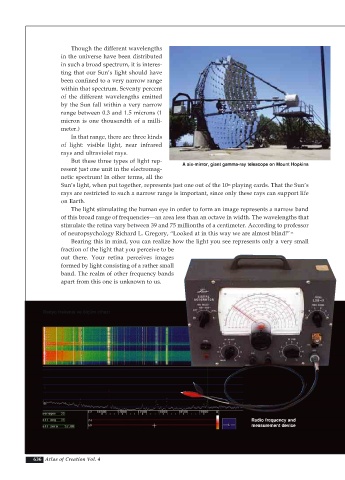Page 638 - Atlas of Creation Volume 4
P. 638
Though the different wavelengths
in the universe have been distributed
in such a broad spectrum, it is interes-
ting that our Sun’s light should have
been confined to a very narrow range
within that spectrum. Seventy percent
of the different wavelengths emitted
by the Sun fall within a very narrow
range between 0.3 and 1.5 microns (1
micron is one thousandth of a milli-
meter.)
In that range, there are three kinds
of light: visible light, near infrared
rays and ultraviolet rays.
But these three types of light rep-
A six-mirror, giant gamma-ray telescope on Mount Hopkins
resent just one unit in the electromag-
netic spectrum! In other terms, all the
Sun’s light, when put together, represents just one out of the 10 playing cards. That the Sun’s
25
rays are restricted to such a narrow range is important, since only these rays can support life
on Earth.
The light stimulating the human eye in order to form an image represents a narrow band
of this broad range of frequencies—an area less than an octave in width. The wavelengths that
stimulate the retina vary between 39 and 75 millionths of a centimeter. According to professor
of neuropsychology Richard L. Gregory, “Looked at in this way we are almost blind!” 32
Bearing this in mind, you can realize how the light you see represents only a very small
fraction of the light that you perceive to be
out there. Your retina perceives images
formed by light consisting of a rather small
band. The realm of other frequency bands
apart from this one is unknown to us.
Rad yo fre kan sı ve öl çüm ci ha zı
Radio frequency and
measurement device
636 Atlas of Creation Vol. 4

